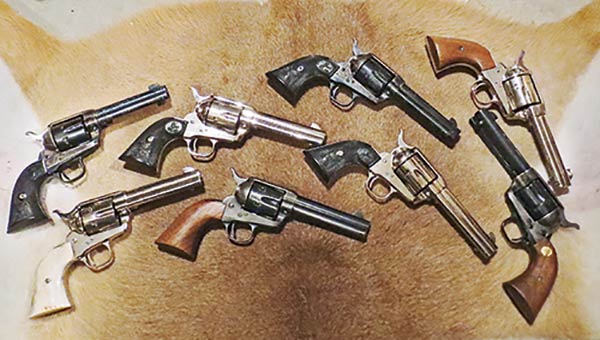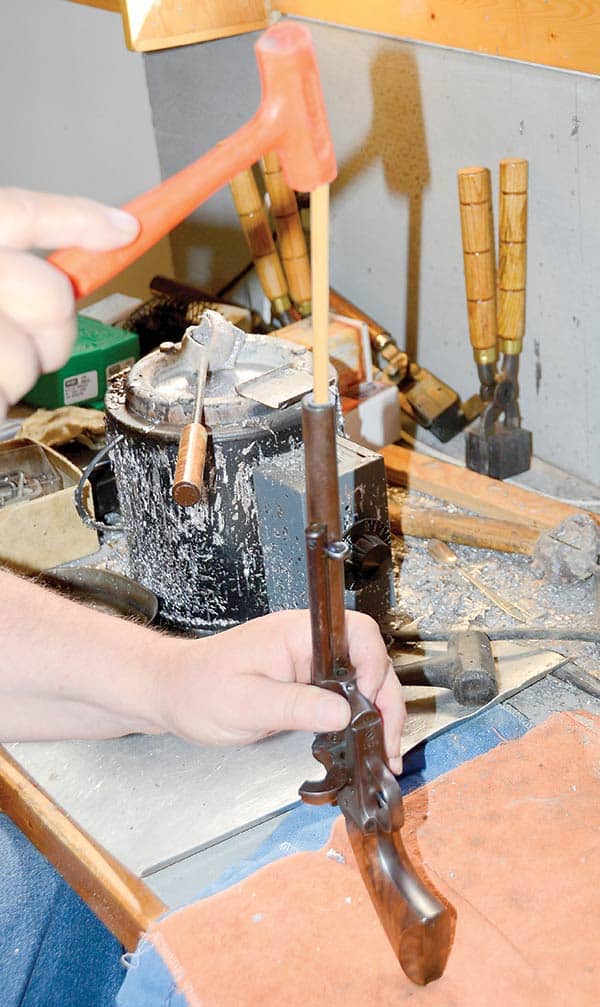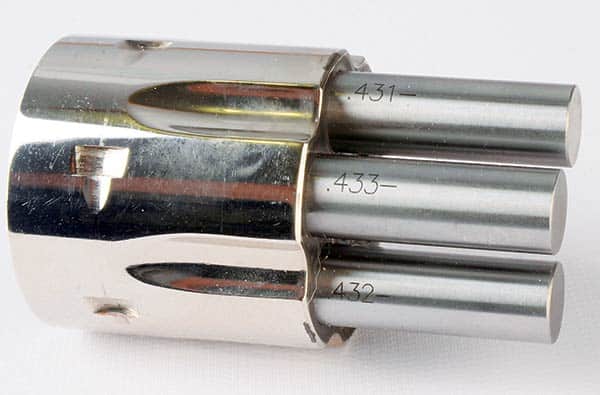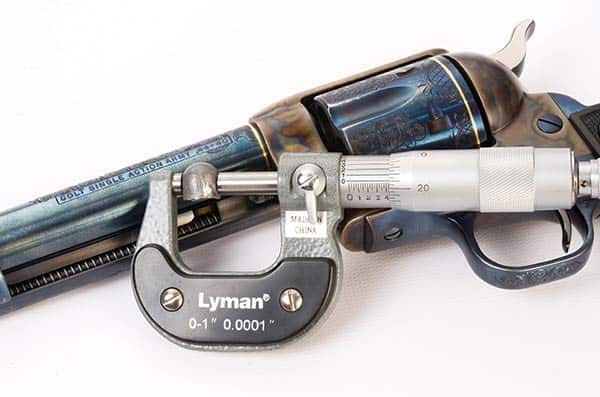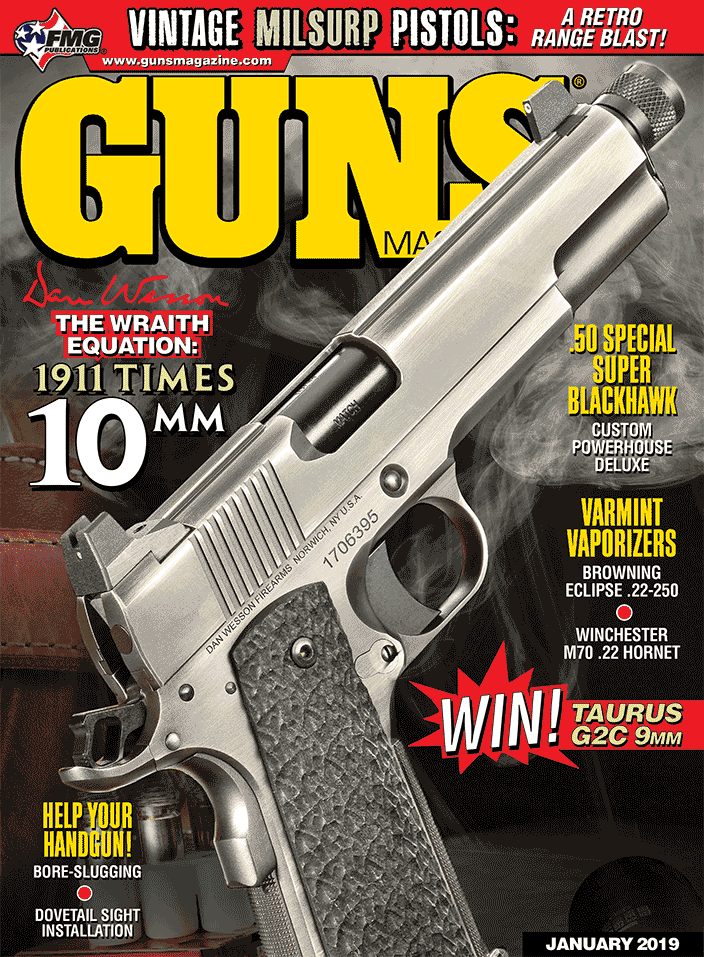Slugging It Out
Pure Lead Tells A “Boring” SAA Story
What does a fellow do to alleviate boredom when it’s 20-below outside and you’re recovering from a full knee replacement? This was my question when the docs released me to move about the house a bit. Into my brilliant mind popped a grand idea — I would slug all the barrels of my Colt Single Action revolvers!
For the uninitiated, slugging is merely pushing a piece of soft lead down the barrel with a piece of wooden dowel and then measuring it. This process gives the barrel’s diameter at its widest point across the grooves.
Gearing Up
For the job I keep a supply of various-sized .45 caliber pure lead muzzleloader balls. Here’s the procedure: squirt a drop of oil on the ball, start it gently into the revolver’s muzzle with a rubber or wood mallet then push it on through with a hardwood dowel. Gently catch the exiting ball and the job is done.
That is — if the barrel has an even number of grooves. Measuring slugs from barrels with an odd number of grooves is a bit different. It requires more complicated techniques and involves a specifically designed micrometer. I have such an instrument but decided to only focus on SAAs during this project because I have more of them than any other model of revolver.
At the same time, every single chamber mouth was measured with plug gauges. These gauges come in a set from a machine tool supply company and start at 0.250, then proceed in .001 increments to 0.500″. For once my brilliant brain told me to save the slugs in a plastic bag along with a card recording the Colts’ serial numbers and all the individual measurements.
Because of space limitations I’ll only discuss the .44 Special and .44-40 Colts because there are some misconceptions about the SAAs built for these two cartridges. In my possession is a Colt factory spec sheet dated 1922 giving the barrel groove diameter for both .44’s as 0.426″ (minimum) and 0.427″ (maximum). Barrel groove depths are .0035 each side. In other words Colt’s .44 barrel bore diameters are 0.419″ to 0.420″.
Some shooters assume because .44 Special factory ammunition has nominal bullet diameter of .429, Colt made a special barrel upon adapting that round to their SAAs. They did not. Shooting soft lead bullets 0.002 to 0.003″ larger than barrels’ groove diameters results in — wait for it — no problem at all!
“Some shooters assume because .44 Special factory ammunition has a nominal bullet diameter of 0.429", Colt made a special barrel upon adapting that round to their SAAs. They did not.
Slugging Surprises
In my slugging project there were seven .44-40’s and three .44 Specials. I also had three extra .44 Special cylinders fitted to .44-40’s so their chamber mouths were included. The time of manufacture of the .44-40’s ranged from 1902 until 2006. The guns from the first generation both had .426 barrel groove diameters. The three made during the third Generation had dimensions at 0.427+. The plus meaning the micrometer showed just a sliver over the 0.427 mark. The two Peacemaker Centennial .44-40’s were made in the mid-1970s and both measured 0.427 precisely. My three .44 Specials — a 2nd Generation one made in 1961 and two 3rd Generation ones made in 1980 — all had 0.426 barrel groove diameters.
As I expected, the chamber mouths were all over the map and vintage didn’t seem to matter much. The 1902 .44-40 mouths were all 0.431 while one of the third generation guns was 0.428 and the other was 0.429″. Both Peacemaker Centennials had 0.429 chamber mouths.
Things got messy with .44 Special cylinders aside from the second generation sixgun — its chamber mouths were uniformly 0.430. Among the third generation .44 Special cylinders, two had 0.433 dimensions for all six chambers while one had four chamber mouths measuring 0.433 and two were 0.432. Another had two at 0.431 and four at 0.432. The remaining cylinder measured one chamber mouth at 0.431, four at 0.432 and the sixth chamber mouth was 0.433″.
It will be interesting to test a couple of the .44-40’s with consistent chamber mouths in a machine rest, then drop in the fitted .44 Special cylinders with inconsistent chamber mouths and compare their groups.
That’s great food for a future column from my self-admitted brilliant brain!
